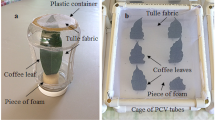Abstract
Competition between Corcyra cephalonica (Stainton) and Ephestia cautelici (Walker) was studied in broken cocoa beans using the two species alone, introduced one before the other and together. Both species of moths cannot co-exist for an extended period and in competition E. cautella becomes extinct. The results offer an explanation of recent evidence that C. cephalonica is rapidly becoming the most important pest of stored cocoa beans in Ghana today.
Résumé
La concurrence entre Corcyra cephalonica (Stainton) et Ephestia cautella (Walker) a été étudié dans les graines de cacao concassées en n’utilisant que les deux espèces, en introduisant un avant l’autre, et en introduisant les deux en même temps. Les deux espèces ne peuvent pas coexister pour une longue période et quand ils sont en concurrence, E. cautella disparaît. Les résultats expliquent la preuve récente que C. cephalonica est en train de devenir l’insecte le plus important, ravageur de graines de cacao emmagasinées au Ghana.
Similar content being viewed by others
References
Allotey J. (1984) Activity patterns of Corcyra cephalonica (Staint.) and Ephestia cautella (WLK.) and competition for pupation sites. Utter Pradesh J. Zool. 4, 150–155.
Allotey J. (1985) Aspects of the biology of Corcyra cephalonica (Staint.) and Ephestia cautella (WLK.) Submitted for publication.
Amoako-Atta B. and Partida G. J. (1976) Sensitivity of almond moth pupae to gamma radiation (Lepidoptera: Pyralidae). J. Kans. ent. Soc. 49, 133–140.
Ayala F. J. (1970) Competition, co-existence and evolution. In Essays in Evolution and Genetics (Edited by Hecth M. L. and Steere W. C.), pp. 121–158. Appleton-Century-Crofts, New York.
Ayyar P. N. K. (1934) A very destructive pest of stored products in South India, Corcyra cephalonica Stanton. Bull. ent. Res. 25, 155–169.
Blakley R. N. R. and Dingle H. (1978) Competition: butterflies eliminate milk weed bugs from a Caribbean Island. Oecologia 37, 133–136.
Ciesielska Z. (1975) Studies of interspecific competition at early growth. Stages of a population of granary beetles Oryzaephilus surinamensis L. (Silvanidae), Sitophilus granarius L. (Curculionidae) and Rhizopertha dominica F. (Bostrychidae) (Col.). Ekol. Pol. 23, 163–183.
Cole L. C. (1960) Competitive exclusion. Science 132, 348–349.
Crombie A. C. (1945) On competition between different species of graminivorous insects. Proc. R. Soc. 132, 362–395.
Debach P. and Sundby R. A. (1963) Competitive displacement between ecological homologues. Hilgardia 34, 106–166.
Debach P. (1966) The competitive displacement and coexistence principles. A. Rev. Ent. 11, 183–212.
Durant J. H. and Beveridge W. W. (1913) Report on the temperature reached in army biscuits during baking, especially with reference to the destruction of the imported flour moth. Ephestia kuehniella. J. R. Army med. Corps 20, 615–634.
Escalante G. and Rabinovich J. E. (1979) Population dynamics of Telenomus fariai (Hymenoptera; Scelionidae), a parasite of Chagas’ disease vectors. IX Larval competition and population size regulation under laboratory conditions. Res. Popul. Ecol. 20, 235–246.
Frank P. W. (1957) Coactions in laboratory populations of two species of Daphnia. Ecology 38, 510–519.
Freeman J. A. (1976) Problems of stored products entomology in Britain arising out of the import of tropical products. Ann. appi. Biol. 84, 120–124.
Gilpin M. E. (1974) Intraspecific competition between Drosophila larvae in serial transfer system (Diptera: Drosophilidae). Ecology 55, 1154–1159.
Grist D. H. and Lever R. H. (1969) Pests of Rice, Tropical Science Series. Longman, London.
Hagvar E. B. (1972) The effects of intra- and interspecific larval competition for food (Myzus persicae) (Horn., Aphidae) on the development at 20°C of Syrphus ribesii and Syrphus corollae (Dipt., Syrphidae). Entomophaga 17, 71–77.
Highland H. A. (1978) Insects infesting foreign warehouses containing package foods. J. Can. ent. Soc. 13, 251–256.
Howe R. W. (1965) A summary of estimates of optimal and minimal conditions for population increase of some stored product insects. J. stored Prod. Res. 1, 177–184.
Huffaker C. B. (1958) Experimental studies on prédation: Dispersion factors and predatory-prey oscillations. Hilgardia 27, 343–383.
Karsholt O. (1978) Some introduced Lepidoptera in the collection of the Zoological Museum, Copenhagen (Tineidae, Pyralidae). Ent. Medd. 46, 65–67.
Laraichi M. (1978) Study of the intra- and interspecific competition between the Oophagus parasites of wheat bugs. Entomophaga 23, 115–120.
Nathanson M. (1975) The effect of resource limitation on competing populations of flour beetles, Tribolium spp. (Coleóptera: Tenebrionidae). Bull. ent. Res. 65, 1–12.
Park T. (1948) Experimental studies of interspecies competition I. Competition between populations of the flour beetles Tribolium confusum Duval and Tribolium castaneum Herbst. Ecol. Monogr. 18, 265–308.
Park T. (1954) Experimental studies of interspecies competition II. Temperature, humidity and competition in two species of Tribolium. Physiol. Zool. 27, 177–238.
Park T. (1962) Beetles. Competition and populations. Science 138, 1369–1375.
Pianka E. T. (1974) Evolutionary Ecology. Harper & Row, New York.
Pontin A. J. (1961) Population stabilisation and competition between the ants Lasius flavus (F.) and L. niger (L.). J. Anim. Ecol. 30, 47–54.
Pruthi H. S. and Singh M. (1945) Stored grain pests and their control. The imperial council of agricultural research. Miscellaneous Bulletin No. 57.
Rafes P. M., Raspovov P. M. and Gninenko J. I. (1979) Food competition of summer-autumn group birch pests in transural (lands east of Ural). Ser. Biol. 1, 63–71.
Rao D. S. (1954) Notes on rice moth, Corcyra cephalonica (Staint.) (Family Galleridae, Lepidoptera). Indian J. Ent. 16, 95–114.
Teotia T. P. and Yougeshwar Singh (1975) Studies on the growth of population of Corcyra cephalonica (Stanton). Indian J. Ent. 37, 272–285.
Umeya K., Kato T. and Kocha T. (1975) Studies on the comparative ecology of bean weevils. VI. Intra-specific competition in Callosobruchus analis (F.) (Col. Curculionidae). Jap. J. appi. ent. Zool. 19, 47–53.
Volterra V. (1926) Variazioni e fluttuazioni del numero d’individui in specie animali conviventi. Mèm. Accad. Lincei. 2, 31–113.
Author information
Authors and Affiliations
Rights and permissions
About this article
Cite this article
Allotey, J., Kumar, R. Competition Between Corcyra Cephalonica (Stainton) and Ephestia Cautella (Walker) in Cocoa Beans. Int J Trop Insect Sci 6, 627–632 (1985). https://doi.org/10.1017/S1742758400009231
Received:
Revised:
Published:
Issue Date:
DOI: https://doi.org/10.1017/S1742758400009231
Key Words
- Corcyra cephalonica
- Ephestia cautella
- competition
- pest
- resources
- generation
- population
- abundance
- exploitation




